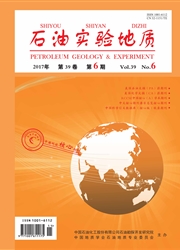

 中文摘要:
中文摘要:
采用电感耦合等离子体质谱(1cPMS)方法对川东南和湘西地区志留系小河坝组37件砂岩样品进行稀土元素及其相关的伴生微量元素含量分析,结果表明该区小河坝组砂岩的稀土总量较高,LREE/HREE及LaN/YbN等比值显示轻、重稀土分异明显,REE分布模式为明显的轻稀土元素富集、重稀土亏损,轻稀土段呈明显的“右倾”,重稀土段则为“平坦状”及明显的Eu负异常,Ce基本正常。稀土元素地球化学特征(Canom)反映了川东南地区小河坝组砂岩沉积时海水介质为缺氧环境,而靠近黔中隆起则为氧化环境。同时稀土元素地球化学特征显示了该区志留系小河坝组砂岩的母岩物质源自活动大陆边缘抬升基底型的古老沉积岩再旋回沉积物和碱性玄武岩混合区。结合前人的研究成果认为,川东南地区志留系小河坝组砂岩的物源来自雪峰山隆起南西段的古丈、芷江、沅陵、怀化及通道一带的新元古界板溪群及其侵入板溪群中的基性、超基性岩体及中基性喷出岩。湘西地区的物源来自雪峰山隆起北东段常德、桃源、安化一带的新元古界板溪群的夹少量中基性喷出岩。
 英文摘要:
英文摘要:
By means of ICP--MS, thirty seven sandstone samples of Xiaoheba Formation have been test- ed, and their rare earth elements and volume of relative associated trace elements have been analyzed. It indicates that total rare earth elements are higher. LREE/HREE and LaN/YbN show that differentiations between LREE and HREE are obvious; LREE is abundant, while HREE is defective. LREE is obviously rightward heeling, while HREE is even, and Eu is obviously negative anomaly, while Ce is normal. According to characteristics of Ce seawater was in an anoxic environment, while it was an oxidizing environment near the Qianzhong uplift. The geochemical characteristics of rare earth elements indicate that the provenance came from active uplifted continental margin. Research results of predecessors suggested that the provenance came from the west wing of Xuefengshan uplift in a line of Guzhang, Zhijiang, Yuanling, Huaihua area, also involved basic rocks, ultrabasic rocks, basic--inter- mediate effusive rocks of Neoproterozoic Banxi Group. Banxi Group also appear in Changde, Taoyuan, Anhua area.
 同期刊论文项目
同期刊论文项目
 同项目期刊论文
同项目期刊论文
 期刊信息
期刊信息
